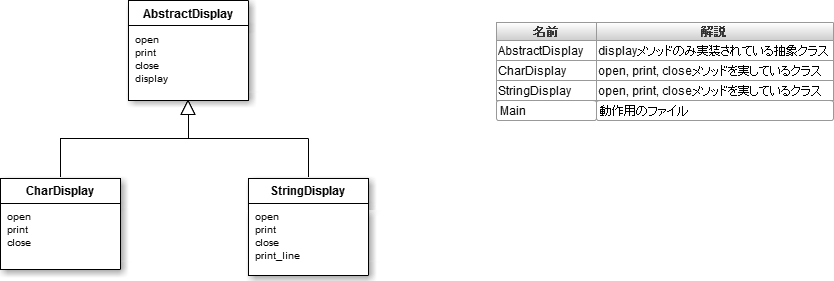Design Pattern #Template Method
I practiced design patterns so that I could write code that was conscious of design. Other Design Patterns will be released frequently.
Preface
- Introduction to Design Patterns Learned in Java Language has been changed from Java to Python. (Python is 3.4.2)
- The code is on github (some of them still don't work)
The primary goal is to understand when, what, and how to use design patterns. (I'm new to Java or a statically typed language, and I don't have a long history of python, so I think there are some things that aren't like Pythonista. If you have any suggestions, please teach me.)
This time, the Template Method of the pattern related to behavior.
What is Template Method?
A design pattern in which the superclass defines the processing framework and the subclass defines the specific content. Is it? In other words, since the algorithm is described by the template method of the superclass, it is not necessary to describe the algorithm one by one on the subclass side. Then, if programming is performed using the Template Method pattern, even if an error is found in the template method, it is possible to reduce the trouble of subsequent correction that only the template method needs to be corrected.
In other words, the rough algorithm should be decided in advance by the superclass, and the concrete design and processing of the algorithm should be done by the subclass.
Overview
The sample program created here displays "characters and character strings repeated 5 times". Here, it consists of three classes, AbstractDisplay, CharDisplay, and StringDisplay, and Main (executable file). The Display method is defined in the AbstractDisplay class. And in the display method, three methods, opening, printing and closing, are used. These three methods are also declared in the AbstractDisplay class, but they are intangible abstract methods. Here, the display method, which uses an abstract method, is the template method. The actual implementations of the open, print, and close methods are the CharDisplay and StringDisplay classes, which are subclasses of the AbstractDisplay class. There is a figure below.

abstract_display.py
from abc import ABCMeta, abstractmethod
class AbstractDisplay(metaclass=ABCMeta):
@abstractmethod
def opening(self):
pass
@abstractmethod
def printing(self):
pass
@abstractmethod
def closing(self):
pass
def display(self):
self.opening()
for i in range(5):
self.printing()
self.closing()
char_display.py
import sys
from abstract_display import AbstractDisplay
class CharDisplay(AbstractDisply):
def __init__(self, ch):
self.__ch = ch
def opening(self):
sys.stdout.write('<<') #If you use print, a blank character will appear immediately after output.
def printing(self):
sys.stdout.write(self.__ch)
def closing(self):
print('>>')
char_display.py
import sys
from abstract_display import AbstractDisplay
class StringDisplay(AbstractDisplay):
def __init__(self, string):
self.__string = string
self.__width = len(string)
def opening(self):
self.__print_line()
def printing(self):
self.print('|' + self.__string + '|')
def closing(self):
self.__print_line()
def __print_line(self):
sys.stdout.write(''.join(('+', '-' * self.__width, '+\n'))) #If you use print, a blank character will appear immediately after output.
main.py
from char_display import CharDisplay
from string_display import StringDisplay
def main():
d1 = CharDisplay('H')
d2 = StringDisplay('Hello, World')
d3 = StringDisplay('Hello')
d1.display()
d2.display()
d3.display()
if __name__ == '__main__':
main()
python main.py
<<HHHHH>>
+------------+
|Hello, World|
|Hello, World|
|Hello, World|
|Hello, World|
|Hello, World|
+------------+
+-----+
|Hello|
|Hello|
|Hello|
|Hello|
|Hello|
+-----+
What is the significance of abstract classes?
The actual processing content can only be understood by subclasses, but it seems important to shape the processing flow at the abstract class stage. If you have an abstract class, the subclass implements the methods that are in the abstract class. Then make the subclass responsible for implementing the method.
Summary
Abstract classes cannot be instantiated. I wondered what the class exists for, such as a class that cannot create an instance, but since the body of the method is not written in the abstract method, I do not know the specific processing content. However, it is possible to decide the name of the method and describe the process by the template method using that method, and by standardizing the process, the possibility of correction and bug can be reduced.
The design pattern is Separation of Concerns (http://en.wikipedia.org/wiki/%E9%96%A2%E5%BF%83%E3%81%AE%E5%88%86%E9%9B% I feel that A2) is the basis.
reference
- TECHSCORE Design Pattern
- Wikipedia Software design pattern
- Wikipedia design pattern
- I made 14 design patterns to learn with Ruby 2.0.0 [GoF] [Design Pattern]
- 5 principles of design patterns by Ruby
Recommended Posts